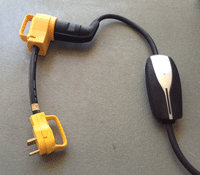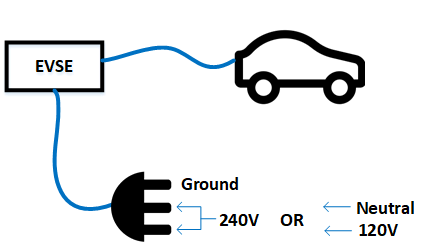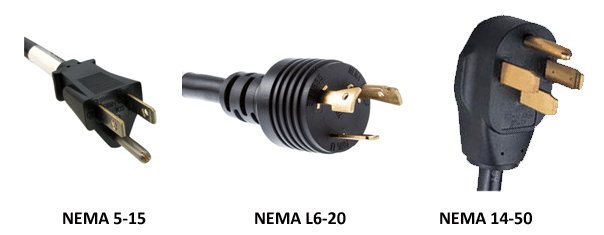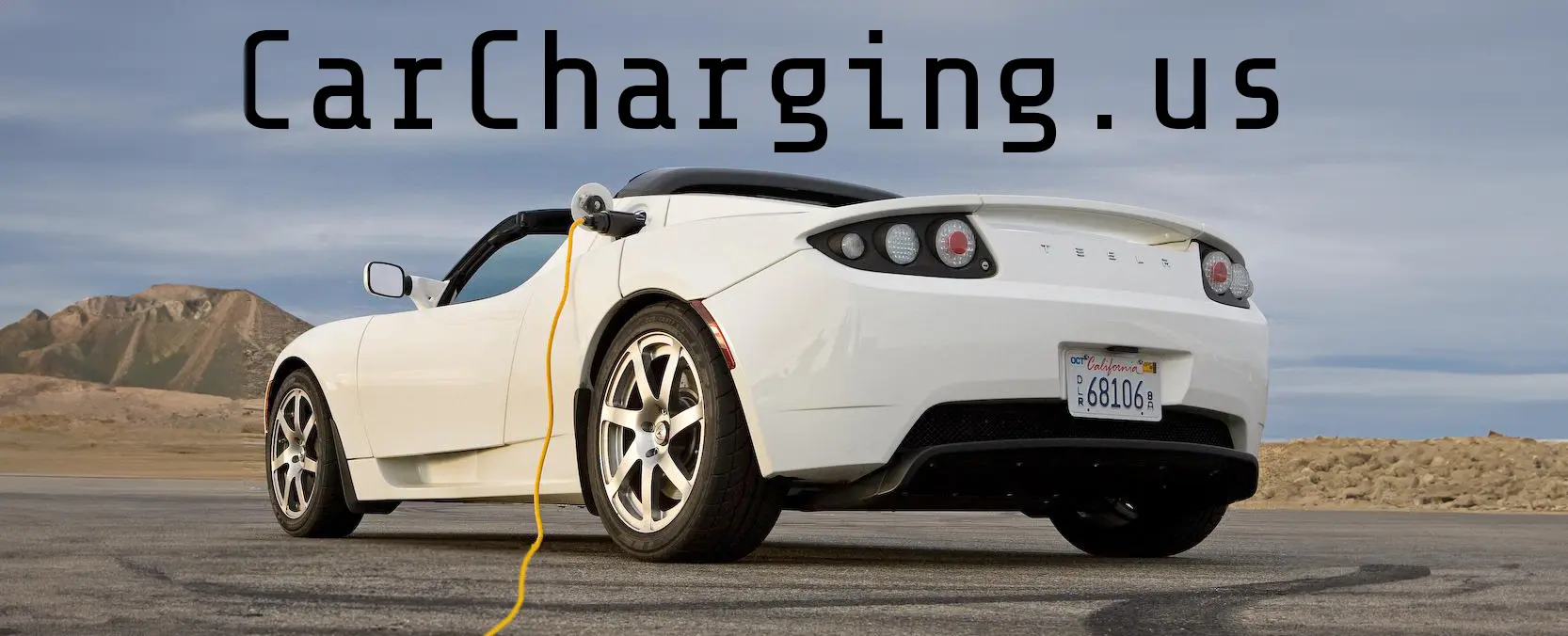How To Make Your Own Adapters
The EV industry has grown up a lot since I put this information together about ten years ago. Today, you can buy pretty much any adapter you want from a reputable online vendor. But I'll leave this info here for the truly odd case.
This page will discuss the theory behind these adapters, and then provide step by step instructions on how to build them.

Here is a typical home made adapter plugged into a mobile EVSE. The adapter is the yellow part on the left. This particular one has a TT-30 plug on the bottom attached to a NEMA 14-50 receptacle on top. The mobile EVSE has a NEMA 14-50 plug. With this adapter, the mobile EVSE can now plug into a TT-30 receptacle.
VERY IMPORTANT: When you use these home made adapters, you are side stepping an important safety feature. With the NEMA 14-50 plug, the EVSE thinks it can draw 40A of current. MOST of the home made adapters plug into sockets that deliver LESS than 40A (like the TT-30 pictured here). So before you use these adapters, go to your car's charging screen (or to the EVSE) and dial down the amps to a safe level. Failure to do this will result in either a breaker tripping (if you are lucky), or the wiring catching on fire. Here's a table showing the safe amps that each type of plug can deliver (80% of the receptacle's rating since charging is a continuous use case), along with the wire gauge to use when making an adapter:
| Receptacle Type | Rated Output | Safe Charging Amps | Wire Gauge |
|---|---|---|---|
| NEMA 5-15 (household socket) |
15A | 12A | 14 |
| NEMA 5-20 (household socket) |
20A | 16A | 12 |
| NEMA 6-15 | 15A | 12A | 14 |
| NEMA 6-20 | 20A | 16A | 12 |
| NEMA 10-30 (dryer) |
30A | 24A | 10 |
| NEMA 14-30 (dryer) |
30A | 24A | 10 |
| TT-30 (travel trailer) |
30A | 24A | 10 |
| NEMA 6-30 |
30A | 24A | 10 |
| NEMA 14-50 (campground 50A) |
50A | 40A or 32A (check breaker) |
6 |
| NEMA 6-50 (welder) |
50A | 40A or 32A (check breaker) |
6 |
| Some 14-50 and 6-50 receptacles have 40A breakers instead of 50A. You MUST check before using or just charge at 32A. | |||
ALSO VERY IMPORTANT: These adapters should only be used for EV charging. If you were to inadvertently use one of these adapters for anything else, you could very well damage your appliance. I recommend labeling each home made adapter with a label that says "For EV Charging ONLY".
Theory of Operation
All EVSEs have three power connections in their plugs. One connection must be connected to a safety ground (EVSEs test for a proper functioning ground), and the other two wires either have 240V between them (each wire is 120V relative to neutral, and 240V relative to each other), or 120V and neutral.

Mobile EVSEs are typically terminated with one of these three plugs (Tesla's Mobile Connector can be terminated with a bunch of different plugs, but most people will choose to use the NEMA 14-50 since it comes with the Mobile Connector and it allows the EVSE to charge at the highest power).

An adapter changes the plug that your EVSE has into the correct receptacle plug you have at your location. It does this by having a receptacle for the plug your EVSE has, a short length of appropriately sized wire, and then a different plug. This completed assembly (receptacle, wire and plug) is called a "pigtail" adapter.
Following is a diagram that shows the pinouts of the RECEPTACLES of most North American plugs. Note the orientation of the ground pin (usually high powered receptacles are shown/installed with ground on top). You can click on the diagram to see/download a PDF of this image.

So, to build an adapter you need:
- A receptacle for your EVSE plug
- A plug for your electrical source
- A piece of wire in between
In general, you connect the grounds of the plug and receptacle together (shown as green in the diagram above), and the hots together. You usually ignore the neutral, but there are exceptions, see below. When making these adapters, I usually like to buy a plug and wire combination so that I only have to wire the receptacle. See below for parts suggestions.
From a NEMA 14-50
When converting from a NEMA 14-50 plug on your EVSE, you just wire the ground of the adapted plug to the ground of the 14-50 receptacle, and the two hots of the plug onto the two hots of the 14-50 receptacle. Ignore the neutral.
If you feed it 120V instead of 240V (to build a TT-30 adapter, for instance), then wire the leftmost blade of the NEMA 14-50 receptacle to the 120V hot, and the rightmost blade to the 120V neutral, assuming you are looking at the face of the NEMA 14-50 receptacle and the ground is on the bottom. Some EVSEs are picky about which pins the 120V/neutral comes in on.
From a NEMA 5-15
When converting from a NEMA 5-15 plug on your EVSE, you just wire the ground of the adapted plug to the ground of the 5-15 receptacle, and the two hots of the plug onto the two blades of the 5-15 receptacle. Only do this if your EVSE is known to be 240V capable (for instance Volt and Bolt included EVSEs from 2016 or later).
To a NEMA 10-30/50
You'll note from the chart above than the NEMA 10-30 and 10-50 have no ground. Only two hots and a neutral. Since EVSEs need a functionaing ground, how do you create an adapter to a NEMA 10-30 or 10-50? The answer is to use the 10-30 or 10-50 neutral pin as a ground. This works because in household wiring, the neutral and ground wires are connected together at the main breaker panel. So when creating an adapter terminating in a NEMA 10-30 or 10-50 plug, connect the 10-30 or 10-50 neutral to the receptacle's ground. This will work in this situation only. As usual, do not use these adapters for anything else.
Buying Pigtail Adapters
There are some on-line stores that make and sell these kinds of adapters for EVs:
Here are some suggested parts to buy if your want to build your own adapters:
- NEMA 5-15 Receptacle
- NEMA 14-50 Receptacle
- NEMA L6-20 Receptacle
- NEMA 14-30 Plug & cord
- NEMA 10-30 Plug & cord
- NEMA 10-50 Plug & cord
- TT-30 Plug & cord (cut off 14-50 part)
- NEMA 6-30/50 Plug
- NEMA 6-20 Plug & cord (cut off receptacle end)
- NEMA L6-20 Plug
- NEMA 5-20 Receptacle & cord (cut off plug end)
The 20A Hack
Some mobile EVSEs allow you to charge at 16A from a 120V receptacle instead of the normal 12A ONLY IF you have an actual NEMA 5-20 receptacle with a horzontal notch on the neutral blade (see 15A or 20A subtitle here for more info about this). However some electricians are lazy or cheap and install NEMA 5-15 receptacles with wire and breakers rated for 20A. In this case only, you can use a cheater plug to "convert" the NEMA 5-15 receptacle to a 20A receptacle and then you can plug your mobile EVSE into the now NEMA 5-20 receptacle. The Tesla Mobile Connector is an EVSE that you could use this with.
3-Phase Adapters
Sometimes people have access to industrial 3-phase power receptacles at their place of work, maybe beside a loading dock. No North American EVSE can use 3-phase power, but you can use an adapter that will extract 208 or 240 volts single phase from a 3-phase receptacle. Here are some links to a company that will make a 3-phase to single phase adapter for a L21-20 or L21-30 plug.
